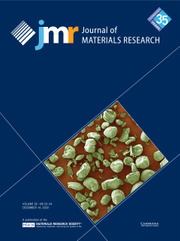Crossref Citations
This article has been cited by the following publications. This list is generated based on data provided by
Crossref.
Khatri, Nishan
Desai, Tithi
Rai, Amit
KC, Pratik
and
Moore, Arden L.
2018.
A batch fabrication-compatible multifunctional thermal sensor based on thin film thermocouple and thermopile elements.
Sensors and Actuators A: Physical,
Vol. 280,
Issue. ,
p.
188.
Guodong, Wang
Yongcai, Song
and
Yongqiang, Li
2018.
Evolution of molecular composition of polycarbosilane and its effect on spinnability.
RSC Advances,
Vol. 8,
Issue. 39,
p.
21863.
Rivera, Kevin
and
Gregory, Otto J.
2018.
Strain Gages for SiC–SiC Ceramic Matrix Composite Engine Components.
IEEE Sensors Letters,
Vol. 2,
Issue. 3,
p.
1.
Rivera, Kevin
and
Gregory, Otto J.
2020.
ITO:SiC Ceramic Matrix Composite Thermocouples for Engine Components.
IEEE Sensors Letters,
Vol. 4,
Issue. 5,
p.
1.
Zhang, Zhongkai
Liu, Jiangjiang
Cai, Rongfu
Liu, Zhaojun
Lei, Jiaming
Sun, Ruolin
Wu, Ningning
Zhao, Na
Tian, Bian
and
Zhao, Libo
2022.
High-Temperature-Sensing Smart Bolt Based on Indium Tin Oxide/In2O3 Thin-Film Thermocouples with Nickel-Based Single-Crystal Superalloy via Screen Printing.
Chemosensors,
Vol. 10,
Issue. 9,
p.
347.
Zhang, Zhongkai
Tian, Bian
Li, Le
Lei, Jiaming
Liu, Zhaojun
Liu, Jiangjiang
Cheng, Gong
Zhao, Na
Fang, Xudong
and
Zhao, Libo
2022.
Thermoelectricity and antivibration properties of screen-printed nanodoped In1.35ZnO2.11/In2O3 thin-film thermocouples on alumina substrates.
Ceramics International,
Vol. 48,
Issue. 18,
p.
25747.
Liu, Yang
Jiang, Hongchuan
Zhao, Xiaohui
Liu, Baorui
Jia, Zhouxia
Deng, Xinwu
and
Zhang, Wanli
2022.
High temperature protection performance of sandwich structure Al2O3/Si3N4/YAlO multilayer films for Pt–Pt10%Rh thin film thermocouples.
Ceramics International,
Vol. 48,
Issue. 22,
p.
33943.
Rivera, Kevin
and
Gregory, Otto J.
2022.
Novel heat flux sensor for SiC-SiC ceramic matrix composite engine components.
Sensors and Actuators A: Physical,
Vol. 345,
Issue. ,
p.
113771.
Liu, Tao
Dong, Helei
Wang, Hanyu
Niu, Yanyan
Li, Xiangpeng
Zhang, Lei
Xiong, Jijun
and
Tan, Qiulin
2023.
Nano cone ITO thin films prepared by pulsed laser deposition for surface measurement of high-temperature components.
Journal of Alloys and Compounds,
Vol. 959,
Issue. ,
p.
170538.
Liu, Tao
Han, Cheng
Ou, Yucheng
Wang, Shanshan
Wang, Bing
Zhang, Xiaoshan
Zhang, Songhe
Song, Quzhi
Du, Yiang
and
Wang, Yingde
2024.
A novel vinyl-bridged graphene oxide/polycarbosilane precursor for harsh environment-resistant ceramic temperature sensor.
Journal of the European Ceramic Society,
Vol. 44,
Issue. 14,
p.
116697.
Li, Shuimin
Zhang, Zhongkai
Wang, Kai
He, Mingzhou
Lei, Jiaming
Li, Le
Tan, Qing
Qi, Rui
Liu, Zhaojun
and
Tian, Bian
2025.
Enhanced temperature sensing performance of T-type TFTCs with SiC encapsulation layer from liquid nitrogen to 900 ℃.
Measurement,
Vol. 251,
Issue. ,
p.
117300.
Gao, Xiangxiang
Zhang, Congchun
Zhang, Shijia
Yan, Bo
Zhao, Nan
Chen, Yi
and
Ding, Guifu
2025.
Conformal fabrication of high-sensitive thin-film heat flux sensor for heat flux monitoring of hot-end components.
Ceramics International,
Vol. 51,
Issue. 20,
p.
29920.
Miller, Chris
Wright, Nathaniel
and
Gregory, Otto J.
2025.
Extension wire system for thin film ceramic thermocouples.
Sensors and Actuators A: Physical,
Vol. 386,
Issue. ,
p.
116343.
Gao, Xiangxiang
Zhang, Congchun
Zhang, Shijia
Wang, Yusen
Zhao, Nan
Yang, Zhuoqing
and
Ding, Guifu
2025.
A heat flux sensor based on ceramic thin-film for ultra-high temperature applications.
Journal of Alloys and Compounds,
Vol. 1020,
Issue. ,
p.
179243.
Wu, Wenqiang
Wang, Xi
Liu, Lechen
Wang, Yaxin
Li, Yao
and
Pu, Hongbin
2025.
Sensitivity improvement of SiC pin temperature sensor by crowded p+ strip structure.
MRS Communications,



